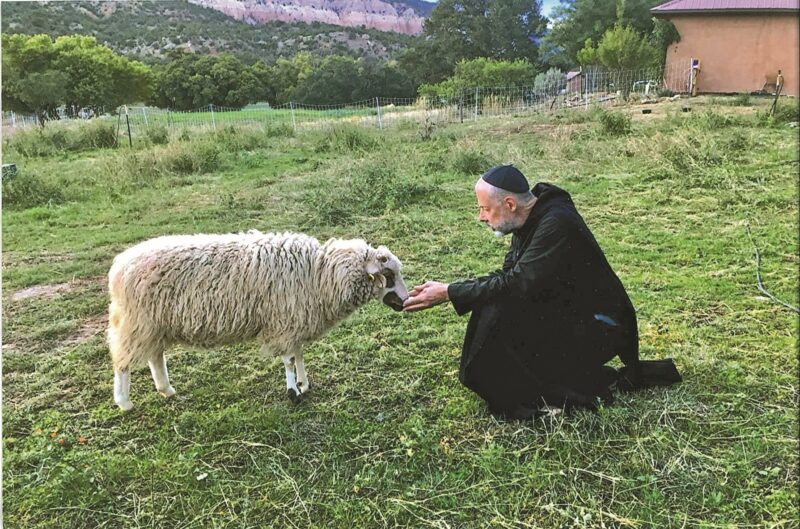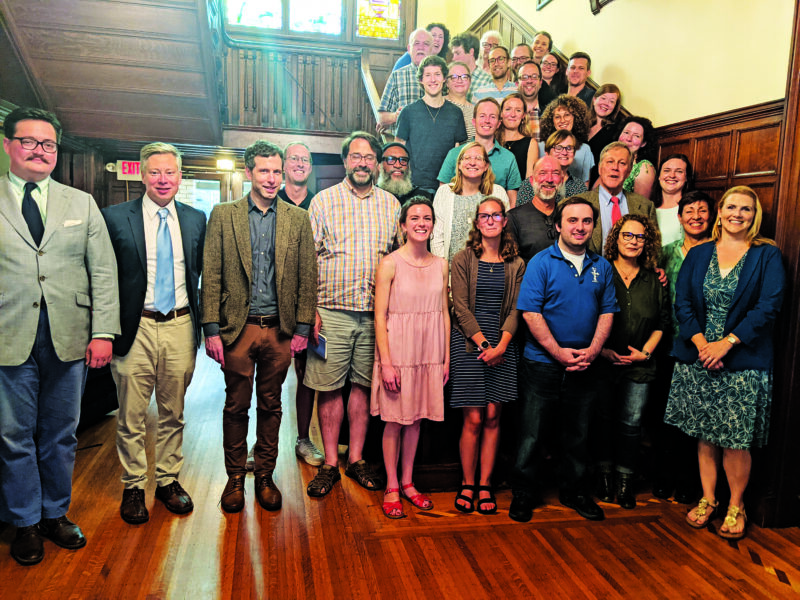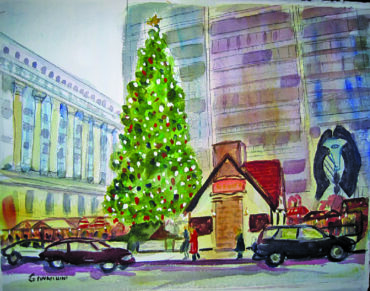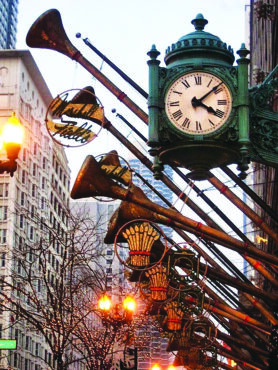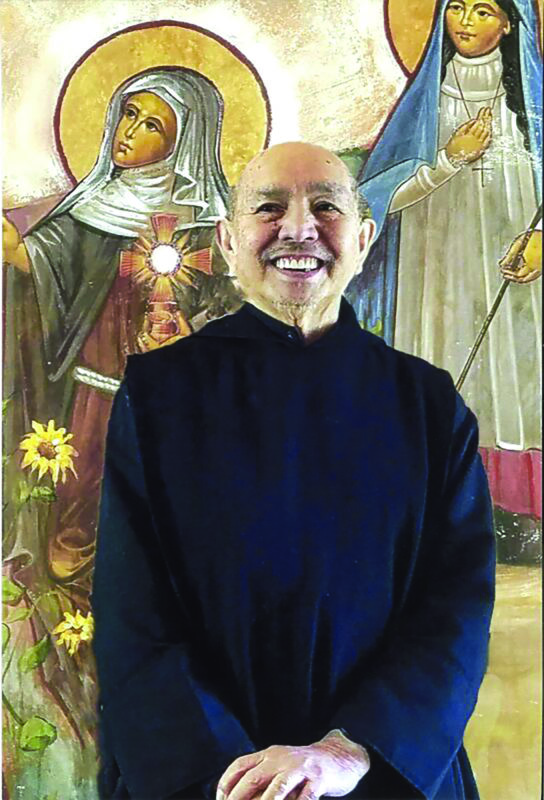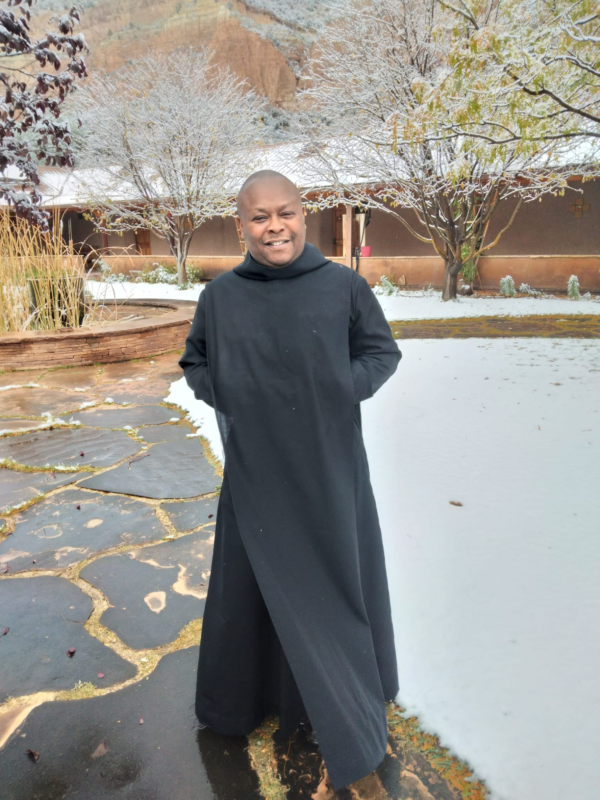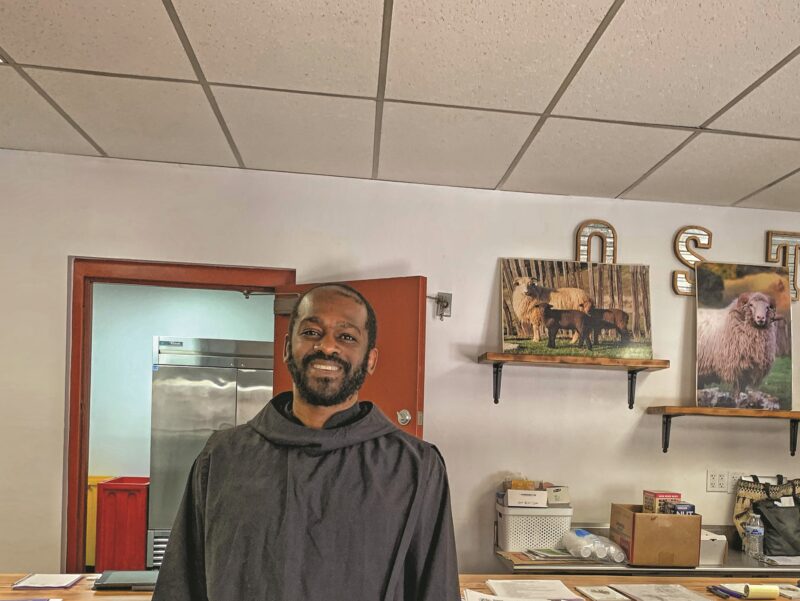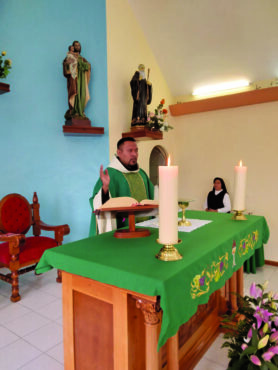Community
While “community” may be a well-worn word in this day and age, that is no reason to stop using it or to cease pondering on its meaning. At the core of the word “community” is the idea of “communion,” a state of being that we hopefully all want to possess and which speaks directly to the nature of who we are as human beings: people who strive to bond in healthy ways with God and with other people.
Another word closely connected to community is “commune,” that is, to relate or interact, to be in contact with God and others. Every person has his or her own level of relating with others. In the 20th century categories, some people are “introverts” and some are “extroverts.” Neither one is better than the other; they are simply convenient formulae used to describe how a person relates to the world and to others.
This year I turn 70, and clearly the years remaining in my life are fewer than ever! I am in excellent health, but that doesn’t mean I won’t die! The reality of life’s brevity makes me ponder more on the “meaning of life,” and my place in the universe. The fact of the matter is that “what is past is prologue,” as Shakespeare wrote, and as for what lies ahead, I am deeply encouraged by the beautiful words of Saint Paul to the Philippians: “straining forward to what lies ahead, I press on toward the goal for the prize of the heavenly call of God in Christ Jesus” (Phil 3:13-14).
For Benedictine monks, the matter of passing through life is best achieved by living with others, forming community, and helping one another along the ups and downs of life’s path. Again, Saint Paul expressed the idea so well in the phrase: “Bear one another’s burdens, and thus you will fulfill the law of Christ” (Galatians 6:2). While this notion is certainly fitting for monks following the Rule of Saint Benedict, it is also something that every person should be aspiring to, living in a world surrounded by needs near and far that might be calling for attention and our care on many different levels.
Recently, during our annual Summer rainy season, two of our monks driving home on Forest Service Road 151 (the dirt and gravel road leading to the Monastery), encountered four visitors outside their vehicle who had hoped to come to the Monastery, but who were “stuck in the mud” in a ditch on the side of the road. The first thing one of the visitors asked the monks was, “do you have a tow truck?” The monks laughed, said we didn’t (as nice as it might be to have one!), but indicated that we do have a tractor and could get it and help the visitors get their car out of its predicament, and so it was accomplished.
I use the example as a way to say that we rely on others, that we are not islands, and we need to think creatively so as to be of greater help in “bearing one another’s burdens.” In a word, we all are part of a community, and as we depend on others, so they depend on us.
Many years ago, as I was getting ready to come and join the Monastery of Christ in the Desert, a friend said to me, “Christ went into the desert for only forty day; you want to go for a lifetime?” My reply was something like this: Christ went to the solitary combat of the desert alone; a monk of Christ in the Desert does so with others, in community, and yes, even for a lifetime.”
The chief occupation of a monk living in a monastery is the unofficial motto of Benedictine life: ora et labora, that is, “pray and work.” All that we do is supposed to be an expression of our faith in God, lived out under the Guidance of the Gospel, the Rule of Saint Benedict and our own particular “Book of Customs” in community. As every person is different, even in a like-minded community, there is no one cookie-cutter way of going to God.
During the Liturgical seasons of Advent and Christmas, we reflect in a special way on the mystery of God becoming human, whose name is “Emmanuel,” that is, God-with-us. Our God became flesh in the context of community, the human race, and desires that all be saved in the same Lord Jesus Christ.
May our personal and communal journeys to God always be guided by the Holy Spirit of God, who with the Father and the Son is adored forever and ever. O Come, O come, Emmanuel!
A very blessed and joyful Christmas 2022 and New Year 2023 to all.
By Abbot Christian
The first thing that may surprise our families and friends about a Monastery Christmas is that we do not start decorating for the Solemnity until December 24th. No trees or decorations are visible in the church, refectory or corridors, inside or out, until the “Night Before Christmas.” Why is that? Christmastide technically begins, in the Catholic Liturgical Calendar, at First Vespers of Christmas, that is, the eventide of December 24th. By then, but not before, trees are decorated, lights are strewn, poinsettias are in place, and the festivities begin.
Our Christmas celebrations on December 24th include significant time in church, chanting the Divine Offices of Vespers, then a little later, Christmas Vigils and culminating in the celebration of Midnight Mass, as December 24th turns into December 25th. After Mass the monks as well as our resident guests and visitors are treated to a festive breakfast (yes, at 1:30 am!), including scrambled eggs, turkey bacon, muffins and more, then off to rest for the monks and guests, and the visitors typically return to their homes, presumably to rest as well.
On the morning of December 25th we pray the Office of Lauds and celebrate Mass of Christmas Day later in the morning, at 11:00 am. In the afternoon, after the Office of None (the Ninth Hour), we have our principal meal of the day, usually something quite special and delicious, though a surprise every year, and prepared by our monks, as are all our meals in the Monastery.
While many people start taking down Christmas decorations and lights within a day or so after Christmas, we monks maintain the mood of comfort and joy which the Christmas Season always brings, for the succeeding “Twelve Days of Christmas.” We cannot be stopped or even slowed down, as we rejoice in the reality and mystery of God-with-us, Emmanuel, who has come that we might have life and have it in abundance.
We suggest to all to consider the “monastery pattern” regarding the celebration of Christmas this year. It may take some adjusting to, but hopefully worth every minute of it, to celebrate with less commercialism, and place the emphasis on the true meaning and spirit of Christmas, when Christ entered time to bring us to eternity.
Some wonderful words from the Norwegian-Danish novelist Sigrid Undset, who lived from 1882 to 1949, come to mind here:
“And when we give each other Christmas gifts in His name, let us remember that He has given us the sun and the moon and the stars, and the earth with its forests and mountains and oceans—and all that lives and moves upon them. He has given us all green things and everything that blossoms and bears fruit and all that we quarrel about and all that we have misused—and to save us from our foolishness, from all our sins, He came down to earth and gave us Himself.”
✠
A Community of Writers and Poets Convene in Houston
By Brother Chrysostom
This summer I attended one of the two writers’ residencies for the Master of Fine Arts in Creative writing from St Thomas University. About 50 students were present representing many States and one joining us from Ireland. I was the one of two religious students in attendance. The other was Fr Phil who is a fine poet. We were called on frequently to give blessings before seminars and meals.
I had the pleasure of finally meeting Prof James Matthew Wilson in person. It was his encouraging conversation more than a year ago that convinced me that Abbot Christian was sage in his urging that I pursue this line of study. Prof Joshua Hren, with whom I had taken four courses over the last year, was also present and was pleased to receive a hand delivered Monastery of Christ in the Desert Newsletter.
The residency began with a Mass celebrated by Cardinal DiNardo in the beautiful Chapel of St Basil on the campus of St Thomas University. He praised Catholic writers and poets in his short homily and reminded us that there are many ways in which the faith is passed along.
Temperatures were high in Houston in late June. I was thankful for the convenience of air conditioning in the classrooms, lecture halls, chapel, and dormitory rooms. Our days followed a rigorous schedule. Breakfast was followed by a joint seminar covering Catholicism East and Far East with poets and writers from 9:30-11:30. The following works were explored: “The Jeweler’s Shop” by John Paul II; the poetry of Czeslaw Milosz; “Silence” by Shusaku Endo; and “Miracles” by Sono Ayako. Following the seminar, I attended Mass at St Basil Chapel with classmates before heading to lunch.
Poets and writers would separate in the afternoon between 3:00-5:00 for workshops. In my workshop for writers, we critiqued each other’s manuscripts. This time face to face rather than via zoom, which was so refreshing! I was able to complete two more short stories over the nine days. After the workshops, students, lecturers, professors would meet at the Link Lee Mansion on campus which houses the President’s Office and other administrative offices for a sumptuous dinner of southern cuisine.
After dinner we would convene in the Jones Auditorium on campus for a two hour lecture starting at 7:15. We heard readings from such Catholic writers as Dana Gioia, (who is wearing a tie and standing on the stairway below in picture,) Robert Royal, Cynthia Haven, Catharine Savage Brosman, Kevin Doak, and Natalie Morrill.
To say that I was exhausted at the end of my ten days at the residency would be a gross understatement. There was not much time, or desire, on my part to do much sightseeing. The heat was a major deterrent, as I said at the beginning. I did, however, find time to visit the nearby Rothko Chapel and walk around the campus and the surrounding neighborhood in the ‘cool’ of the evening.
Notwithstanding, what made the time spent at the residency extraordinary was the literary conversations, the strengthened friendships, the communal worship, and the sense of belonging to a community of Catholic writers who are continuing in the tradition of such great writers as Flannery O’Connor, Walker Percy, and Thomas Merton. I hope one day to share the fruits of this learning with our readers and others.
✠
Chicago Christmas Carol
By Brother Chrysostom
The theme of this newsletter referenced community. While at the writers’ residency this summer I learned about flash fiction (a short story consisting of less than 1500 words). I wish to share with you a Christmas themed piece that showcases a community that I love and that shaped me, Chicago. I have learned as a monastic that it is what we bring from the communities that formed us to the monastery that creates the vibrancy of intimacy between monks. I hope the story achieves a threefold purpose: 1) sharing the fruits of a Creative Writing MFA with supporters of our Educational Appeal, 2) sharing Chicago with a wider audience, and 3) building a monastic community where art and letters complement evangelization. I hope you enjoy it. Merry Christmas.
Aunt Jane is my mother’s older sister and my favorite aunt. Every early December after the first of the holiday specials–Rudolph the Red Nose Reindeer, A Charlie Brown Christmas, Santa Clause is Coming to Town–airs on ABC and CBS, Aunt Jane arranges for me and her to have our Chicago Christmas.
It is late Sunday morning. Mom and Dad have gone to 8:00 am Mass at Our Lady of Peace. They let me sleep in. I miss Frisky. He had to be put to sleep three days ago because the vet told us that his problems wouldn’t get any better. I am a big boy. I can understand. I am almost ten years old and I can stay at home alone while my parents go to Mass three short blocks away. When they come home, I want to stay in bed. They will get me out of bed and rush me to get ready because Aunt Jane is coming over soon.
I wash up quickly, put on my brown thick cord corduroy pants, my cordovan Buster Brown shoes, t-shirt, clean white collar shirt, and a crew neck sweater with bands of light brown and black. I make sure that my afro is neat and fluffy with my pick in front of the bathroom mirror. I hear the horn of Aunt Jane’s 1970 Blue Dodge Dart outside. Quick kisses and hugs from my mother and father and a rush to grab my loden coat, knit skull cap, scarf, and mittens heralds the metallic clang of the storm door closing behind me. I bound down the steps while humming the finale of A Charlie Brown Christmas. The soles of my Buster Brown shoes make scuffed tracks in the thin layer of snow to the back door of Aunt Jane’s car.
No sooner do I close the door and kiss the back of her neck, which has the chemical smell of the relaxer that her hairdresser uses, than the car is gliding down our neighborhood toward Lake Shore Drive. We are going downtown. Downtown! Snowmen, nutcrackers, and Santas populate the front yards of the neat bungalows we pass along the way. Strings of lights outline doorways and wrap around exterior ferns and trees. The lights excite me, but I know that the lights on State Street are better.
Aunt Jane finds parking easily on Madison Avenue and we get out of the car and walk a block or so to St Peter’s Catholic Church. Aunt Jane works for Catholic Charities downtown and attends Mass here most mornings before starting her work day. She loves this church with its high ceilings. The Franciscans in their brown robes and knotted rope belts and sandals are happy to see us. She likes the Franciscans, too. We make it in time for Mass. There are no Christmas decorations. The outside world with lights and decorations doesn’t know that Christmas is still a week and days away. They don’t care. They are going to have Christmas before the baby Jesus even comes at Midnight Mass! I kneel down before Mass and say a prayer for Frisky. One of the Franciscan priests comes over and hugs Aunt Jane as I pray. I want to ask him if dogs go to heaven, but I don’t.
After Mass we file out of church into the cold with some other people and make our way to Marshall Fields & Company. I can read street signs. We take a left down Clark Street and then up Washington Street. Aunt Jane wants to show me the Picasso in Daley Plaza. It reminds me of a dragon, but the large Christmas tree close by makes it less scary. The large jutting clocks on the corner of the Marshall Fields & Company department store look so heavy. I don’t want them to crush me. The illuminated faces on the clock have hands that mean something to me. I can tell time. It was 12:20 pm.
We pass through a heavy revolving door into a Christmas palace. A large Christmas tree higher than my house stands in the middle of the store. Gold, silver, red, and blue bulbs hang off branches. There are also rocking horses, tin soldiers, teddy bears, clowns, elves, and other presents decorating the biggest Christmas tree I have ever seen. Aunt Jane holds my hand tightly and we wind through the cosmetic section, the chocolate section, and the handbag section to one of the many wooden escalators that will take us up to the Walnut Room. We pass my favorite floor, the 4th floor, that has toys. But, I don’t care.
There is a long wait in line to eat lunch. My legs are getting tired, but we are finally seated at a table next to the top of the huge Christmas tree that we saw when we first came in. A model train is making its way around a track above our heads. We order hamburgers which came with special French fries that were almost like fat potato chips. I don’t like my hamburger because the bun has butter on the inside. “Herbert, eat your hamburger, the butter is supposed to make it moist,” Aunt Jane said. I eat my hamburger, but I want a McDonald’s Quarter Pounder with cheese.
After lunch, Aunt Jane goes shopping in the ladies’ section which goes up several floors. I ask if I could go to the 4th floor and look at the toys. Aunt Jane agrees, but tells me to wait for her down there. I have fun looking at the space ships and castles. The large die cast toy cars are my favorite. Buried within the mound of Gund animals of different sizes is a dog that looked like Frisky. I like it. But I want a real dog. I so hope Santa would bring me the Batmobile with the launching rockets that I want.
When we leave Marshall Fields & Company the large three faced clock on the corner of Randolph and State reads 3:30 pm. As the sky grows darker and the Christmas lights along State Street grow brighter, Aunt Jane and I join the procession of Christmas window gazers who joyfully file by animated windows of Christmas scenes for the next five blocks. Large department stores like Carson Pirie Scot, Sears, Montgomery Ward, Wiebolt’s, and Goldblatt’s each Christmas season deck their windows with Santas, reindeer, snowmen, and elves.
Aunt Jane who is much taller than I sees it before I do. She puts her hands on the shoulders of my loden coat and leads me through the crowd closer to the corner of the store. At the last Marshall Fields & Company window before crossing Washington Street to Carson’s, there was a winter wonderland scene with children ice skating, throwing snowballs, and sledding down hills. In the corner of the snow scene is a lone boy and a dog playing catch. The boy doesn’t look like me at all, he has yellow blonde hair, but the dog looks just like Frisky! I smile at Aunt Jane and she hugs me. Hark the Herald Angels Sing is playing on a speaker at Carson Pirie Scot across the street. Snow is coming down. Aunt Jane takes my hand and leads me away from the Frisky in the window. She knows that Santa would have Max, a small wirehaired terrier puppy, under my Christmas tree soon.
- Richard J. Daley Plaza
- Marshall Fields & Company Clock
Cloister Humor: Recently, the Brother who arranges for medical appointments was getting flustered both with the quality of our phone connection and with the receptionist at the optometrist’s office. When the word “glaucoma” couldn’t come to the Brother’s mind, he kept saying instead, “guacamole.” The receptionist wasn’t amused nor understood what the medical issue was. Finally, the Brother remember the word “glaucoma,” and the appointment was made.
✠
In Loving Memory
by Abbot Christian
Our dear confrere, Father Luis Regalado, recently passed away, having celebrated his 79th birthday, on June 20th, 2022. He had suffered a massive stroke on June 26th, and was taken to the hospital, where he died while we monks were at Mass on the morning of June 28th.
Father Luis had been a professed monk of Christ in the Desert for almost 24 years and a priest for 38 years.
May the angels lead Father Luis into Paradise!
May Father Luis and the souls of all the faithful departed, through the mercy of God, rest in peace.
Abbot Christian and the monks
✠
What is your name and age?
Br. Charles Macharia Kariuki; I am 40 years old.
How long have you been a monk at MCD?
I have been a monk at the monastery for ten years. I was born in Rift Valley, Kenya, in a large city called Eldoret City. I have three sisters and I am the last born, and the only son in an active Catholic family. I learned about Christ in the Desert through its website in 2009.
What were some of your challenges as a monk at MCD during your time here?
The adjustment from active life as a real estate manager to contemplative life required patience and perseverance.
What changes have you witnessed during your time here at MCD?
It was a privilege to live and pray with the brothers at Poloquane in South Africa for the past three years. Now taking care of our elderly monks is a new act of charity which I embrace. And, serving as a cook for the monastery is a challenge, but I am ready!
Who is your favorite saint, and why?
Saint Vincent de Paul is dear to me. I am impressed with his charity. And, of course, my patron St. Charles Lwanga from Uganda, is my favorite saint!
✠
Brother David s Conference
Brother Chrysostom
Brother David immersed himself in the community of the Navajo-Churro Sheep Association at their 2022 annual meeting held October 15-16 in Moab, Utah. Brother David gave a presentation entitled “Possessing: Places, Processes, Branding.” Br David shared about our own growing flock of sheep and some of the fine products that we have produced with the wool we have accumulated. His presentation addressed the different types of wools used by makers of clothing, rugs and blankets. Furthermore, he identified several mills in Colorado, Wyoming, Wisconsin, Michigan, Utah, and Iowa where were Association members can have their wool sent and processed into skeins. Did you know that Navajo-Churro Sheep produce about 4 to 5 pounds of wool per sheering? Most mills that process wool want about 35 lbs of wool minimum weight. So, you need at least seven sheep of the same color to meet the minimum. After a lengthy discussion about the processing of wool, Brother David gave helpful tips on next steps, such as branding, getting the word out, and consistency. Brother David’s presentation was well received; and, just one of the many presentations over the two-day meeting.
The two days of breakout sessions and presentations covered topics such as general nutrition for sheep, strategies on culling and selecting breeding rams, and how to choose, produce and sell sheep, wool, and meat. There was a Sheep Show and Inspection workshop (which hopefully bore no resemblance to that fine comedic movie Best in Show, from 2000). It was good for Br David to meet with Association members and gain exposure to their best practices, as well as showcase the growing capabilities of the monk weavers and animal husbandry specialists.
✠
Father Gregorio s Ordination
By Abbott Christian
On Saturday morning, September 3rd, 2022, our Brother Gregorio Carrizal Dolores, OSB, was ordained a priest by Archbishop Jorge Carlos Patron Wong, of the Archdiocese of Jalapa, Veracruz, Mexico. Brother Leander and I attended the ordination at the Jalapa Cathedral.
Our monastery of Santa Maria y Todos Los Santos, to which Father Gregorio belongs, is located within the Archdiocese of Jalapa.
After the ordination Mass, some three hundred people enjoyed delicious food, fraternal conversation and sensational music by a band of players typical of Veracruz (think of the song, “La Bamba,” originating in Veracruz).
We are very proud of our brother Gregorio, for his learning a new language (Italian!) and for his perseverance in study of Theology and Monastic studies in Rome over the past three years. Father Gregorio returned to Rome for further studies in October.
- Father Gregorio
- First Mass with Sisters in Jalapa

